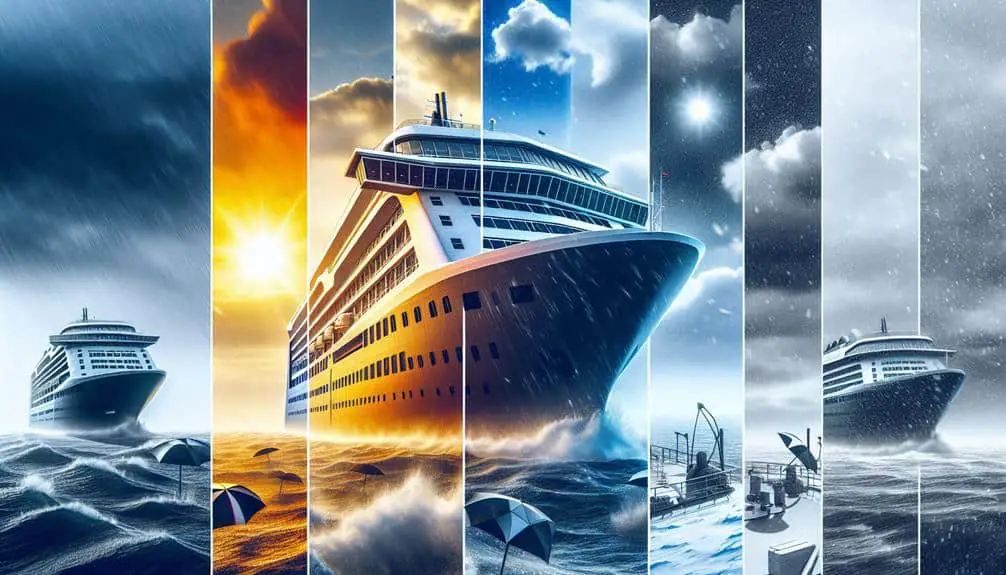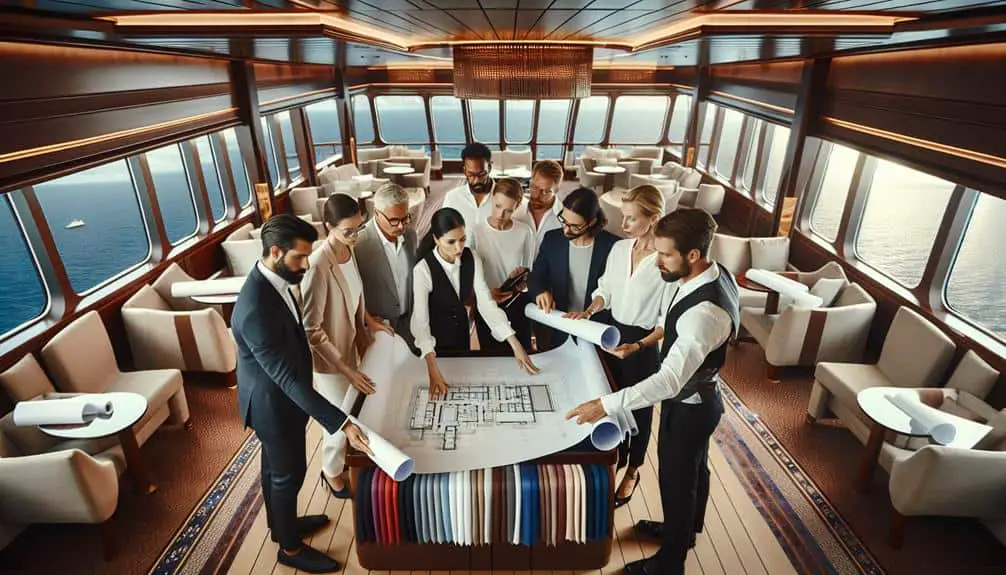Opt for aluminum alloys for durability and fuel efficiency. Choose marine-grade paints for long-lasting protection against corrosion. Consider fiberglass composites for exceptional durability and structural integrity. Opt for stainless steel cladding to boost resistance to harsh maritime conditions. Select synthetic decking materials for low maintenance and resistance to moisture and UV rays. These materials enhance cruise ship exteriors, ensuring longevity and protection.
Key Points
- Aluminum Alloys: Lightweight, corrosion-resistant, and high strength for durability and fuel efficiency.
- Marine-Grade Paints: Formulated for maritime environments, ensuring long-lasting corrosion protection.
- Fiberglass Composites: Lightweight, durable, and corrosion-resistant with high strength-to-weight ratio.
- Stainless Steel Cladding: Offers exceptional corrosion resistance and low-maintenance durability.
- Synthetic Decking Materials: Low-maintenance, moisture and UV resistant, but prone to heating and scratching.
Aluminum Alloys
When selecting materials for cruise ship exteriors, aluminum alloys stand out as a durable and lightweight option that offers excellent corrosion resistance. Aluminum alloys are highly favored in marine applications due to their exceptional strength-to-weight ratio, making them ideal for constructing cruise ship exteriors.
The corrosion resistance of aluminum alloys is a key feature that guarantees the longevity and structural integrity of the ship's exterior components, protecting against harsh seawater and environmental conditions.
The lightweight design of aluminum alloys not only contributes to fuel efficiency but also eases the overall weight burden on the cruise ship, allowing for enhanced speed and maneuverability. When considering the demanding conditions at sea, the ability of aluminum alloys to withstand corrosion while maintaining structural reliability is paramount.
Incorporating aluminum alloys in the construction of cruise ship exteriors ensures a balance between durability, weight reduction, and resistance to corrosion, making it a top choice for maritime engineering projects.
Marine-Grade Paints
For cruise ship exteriors, the application of marine-grade paints is essential to guarantee long-lasting protection against harsh maritime environments. These paints are specifically formulated to withstand the challenging conditions at sea. Durable coatings are a hallmark of marine-grade paints, providing a robust shield against saltwater, UV radiation, and weathering. The corrosion resistance of these paints is paramount for maintaining the structural integrity of the ship's exterior surfaces.
When selecting marine-grade paints for cruise ships, it's important to take into account factors such as adhesion strength, flexibility, and color retention. These paints are engineered to adhere firmly to the ship's surfaces, even in the face of constant exposure to saltwater and abrasive conditions. Their flexibility allows them to expand and contract with the ship's metal surfaces without cracking or peeling. Additionally, superior color retention ensures that the ship maintains its aesthetic appeal while being adequately protected.
Fiberglass Composites
Durable and lightweight, fiberglass composites are integral components in enhancing the structural integrity of cruise ship exteriors. Their lightweight design contributes to the overall efficiency of the ship without compromising on strength. Fiberglass composites provide exceptional durability, ensuring a long-lasting solution for the harsh maritime environment.
These composites are known for their superior structural integrity, offering high strength-to-weight ratios that are essential for maintaining the stability and safety of cruise ships. Additionally, fiberglass composites exhibit excellent resistance to corrosion, protecting the ship's exterior from the corrosive effects of saltwater and other environmental factors.
Stainless Steel Cladding
Stainless steel cladding serves as a protective layer on cruise ship exteriors, enhancing resistance to harsh maritime conditions. This material is chosen for its exceptional corrosion resistance properties, essential for withstanding the constant exposure to saltwater and atmospheric elements. The sleek appearance of stainless steel cladding not only contributes to the aesthetics of the cruise ship but also provides a durable and low-maintenance solution for exterior surfaces.
When properly installed, stainless steel cladding forms a barrier that shields the underlying structure from corrosion, extending the lifespan of the ship's exterior components. Its resistance to rust and staining makes it an ideal choice for maritime applications where durability is paramount. Additionally, the reflective nature of stainless steel can help reduce heat absorption, contributing to energy efficiency onboard.
Synthetic Decking Materials
Enhancing the resilience of cruise ship exteriors, synthetic decking materials offer a durable and low-maintenance solution for maritime applications. These materials, typically made from PVC or composite blends, present several benefits for cruise ships. Synthetic decking is resistant to moisture, UV rays, and staining, making it ideal for withstanding the harsh marine environment. Additionally, it requires minimal upkeep, reducing maintenance costs and labor hours.
One of the primary drawbacks of synthetic decking materials is their tendency to heat up in direct sunlight, potentially making them uncomfortable to walk on barefoot. Furthermore, some lower-quality synthetic materials may fade over time when exposed to continuous sunlight and harsh weather conditions. While synthetic decking is generally easy to clean, certain types may be prone to scratching and scuffing, requiring careful handling to maintain their appearance.
Frequently Asked Questions
How Do Cruise Ship Exteriors Withstand Extreme Weather Conditions Such as Hurricanes and Heavy Storms?
To withstand extreme weather conditions like hurricanes and heavy storms, cruise ship exteriors rely on weatherproof materials. These materials offer durability, impact resistance, and longevity, ensuring the ship can navigate challenging conditions without compromising its structure.
What Measures Are Taken to Prevent Corrosion and Rust on Cruise Ship Exteriors Over Time?
To prevent corrosion and rust on cruise ship exteriors over time, you must prioritize maintenance. Regular inspections, coatings, and using weather-resistant materials combat deterioration. Durability against extreme weather is essential for long-term preservation.
Are There Specific Maintenance Routines That Need to Be Followed to Ensure the Longevity of Weatherproof Materials on Cruise Ship Exteriors?
To guarantee the longevity of weatherproof materials on cruise ship exteriors, maintenance schedules are vital. Regular coating applications and thorough inspection protocols not only safeguard the ship but also assure its durability against harsh elements.
How Do Cruise Ship Exteriors Deal With Saltwater Exposure and Potential Damage From Salt Corrosion?
Ever wondered how cruise ship exteriors combat saltwater exposure and corrosion risks? Marine coatings provide robust saltwater protection, while corrosion-resistant metal alloys are essential. These synergistic solutions uphold the ship's durability amidst challenging maritime environments.
Are There Any Eco-Friendly Weatherproof Materials Being Used in the Construction of Cruise Ship Exteriors?
When considering eco-friendly solutions for cruise ship exteriors, sustainable options like recycled composite materials or advanced coatings can provide protection against saltwater exposure. These materials offer durability without compromising on environmental impact.



